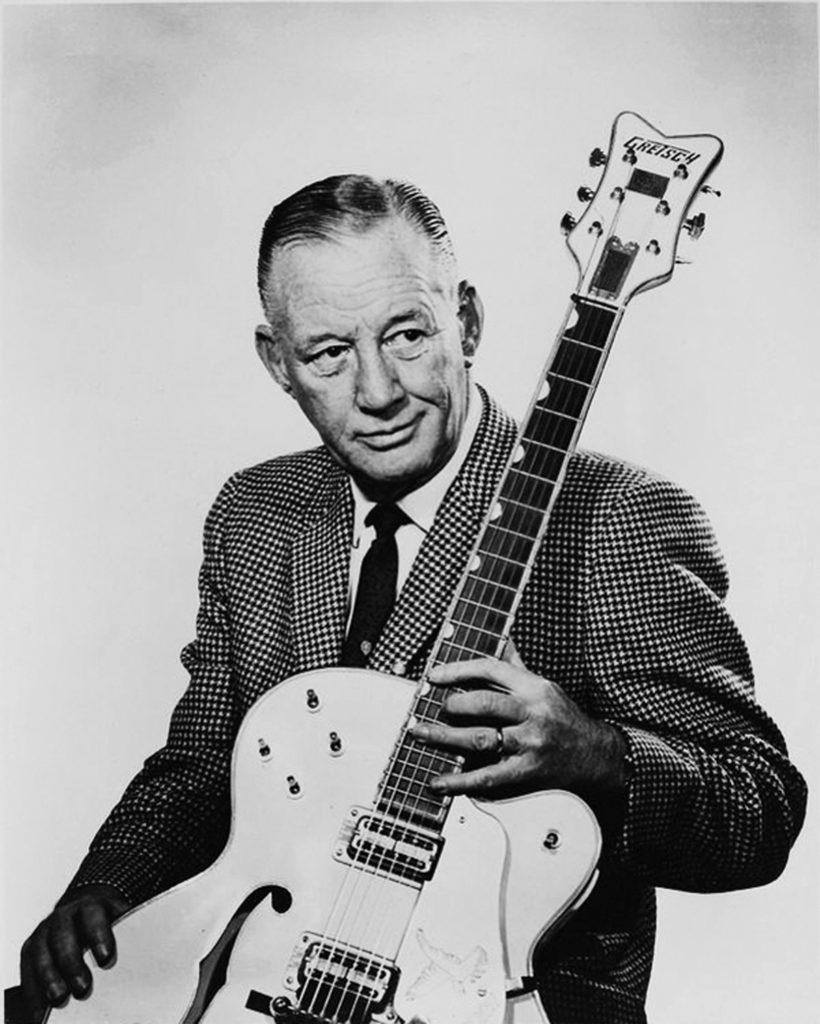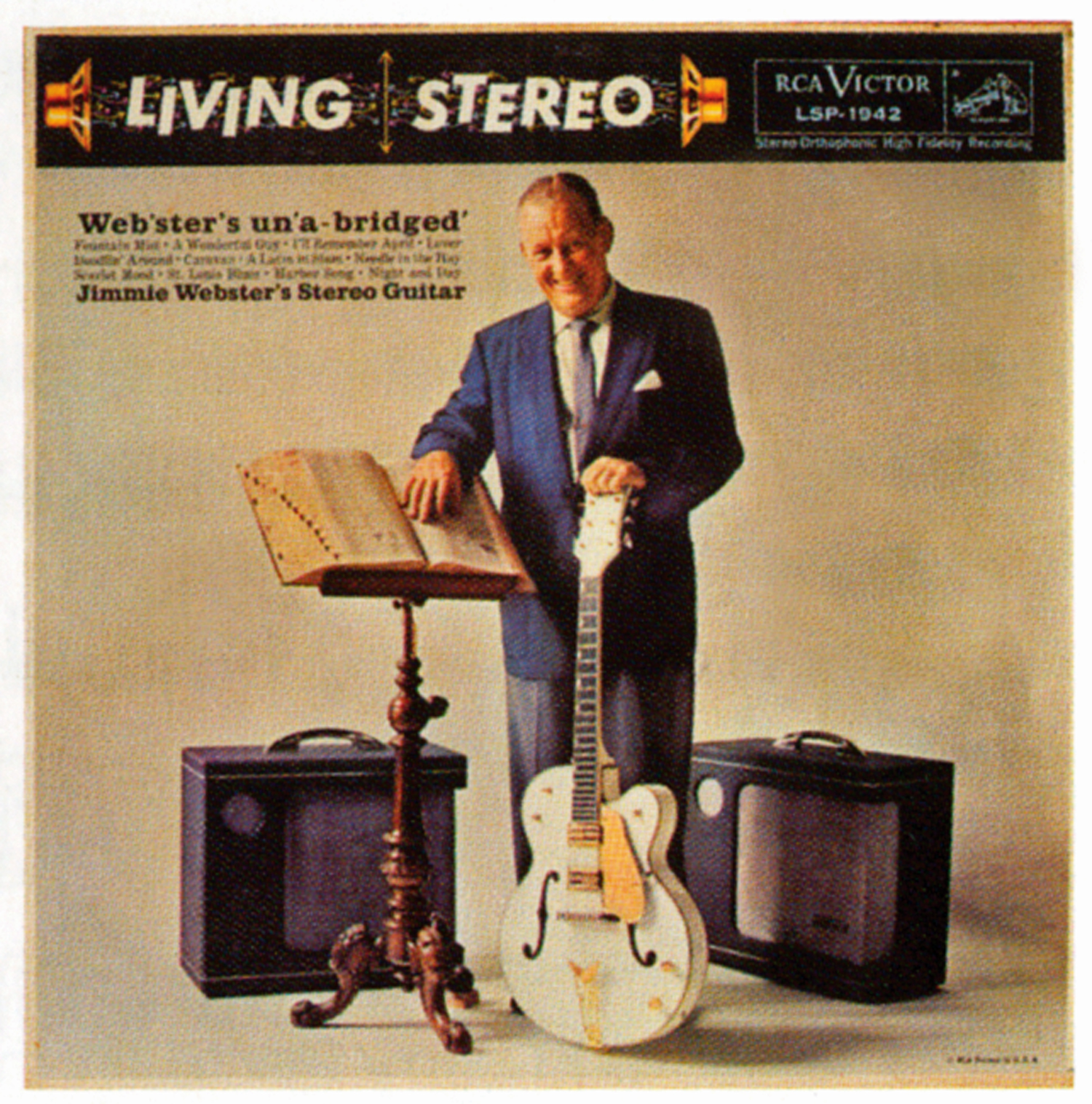Jimmie Webster: A Great Gretsch Ambassador
Gretsch Celebrates the Birthday of a Colorful Musician, Inventor, and Traveling Ambassador for Gretsch Guitars.
 Jimmie Webster was born on August 11, 1908 in Van Wert, Ohio into a very musical family. Both parents played as well as taught piano and his sister, Virginia, became a well-respected jazz pianist. Keeping the family tradition alive, Webster excelled at piano but also had a passion for the guitar.
Jimmie Webster was born on August 11, 1908 in Van Wert, Ohio into a very musical family. Both parents played as well as taught piano and his sister, Virginia, became a well-respected jazz pianist. Keeping the family tradition alive, Webster excelled at piano but also had a passion for the guitar.
In the 1930s Webster was a professional musician in the New York City area and married L’Ana Hyams, one of the first women jazz bandleaders. Webster was also an in-demand professional piano tuner, ran a small music store, and began doing a little consulting work for the Gretsch Company.
During World War II Webster served as a musician in the U.S. Air Corps in Iceland. After the war, Webster moved to Long Island, N.Y. where he became more involved with the Gretsch Company. Webster’s long association with Gretsch guitars would span four decades.
The 1950s: A Golden Decade for Jimmie Webster and Gretsch Guitars.
In 1951 Gretsch informed the music industry (and market leader Gibson) it was serious about manufacturing a professional line of electric guitars. Webster led a successful, three-day promotional show for music dealers and professional musicians at New York’s Park Sheraton Hotel. Webster demonstrated the new Gretsch single cutaway Electromatic and Electro II hollow body electric guitars. Based on industry trade journals, the event was well attended and very successful in getting Gretsch the awareness and exposure the company needed.
Throughout the decade, Webster proved to be Gretsch’s main “idea man” in his quest to distinguish Gretsch guitars from the competition. Webster and Gretsch led an industry “color revolution” and took guitars beyond their conservative natural or sunburst finishes. It was Webster’s idea to cover the top of the solid body Silver Jet guitar with a flashy, sparkle drum finish from Gretsch’s drum department. He also took marketing cues from the auto industry by introducing guitars finished in Cadillac Green, Jaguar Tan, and Copper Mist and conducting traveling “Guitarama” shows and demonstrations around the country.
1954 was truly a banner year for Gretsch and Jimmie Webster. At the July Summer NAMM Show Webster unveiled the ultimate “dream guitar”, the opulent White Falcon. Designed more as a concept “guitar of the future” than an actual production guitar, Webster’s stunning white and gold beauty caused such a stir with sales reps that Gretsch had no choice but to offer it in their 1955 lineup. It was-and remains today-the “Cadillac of Guitars”.
In an effort to match Gibson’s recent endorsement of Les Paul, Webster set his sights in 1954 on landing Gretsch’s first signature guitar with one of the industry’s most talented guitarists, Chet Atkins. Although he resisted at first (Atkins was happy with his self-modified D’Angelico), Atkins finally agreed once Webster told him he could design his own signature guitar. The result was the legendary Chet Atkins Hollow Body Model 6120. Launched in 1955, this milestone electric guitar with its distinctive orange finish, fire-branded “G”, and western-themed appointments put Gretsch on the map and forever changed the company’s fortunes and popularity.
Ever the inventor and in search of the next innovation, Webster patented and introduced a line of Project-O-Sonic stereo guitars in 1958. With split Filter’Tron pickups and dual amplifiers, Webster proclaimed it to be the biggest revolution in guitar engineering since electrification.
 The stereo guitar sounded impressive when played by a talented guitarist and Webster proved that with his landmark Webster’s Unabridged LP. Not only did it showcase his Project-O-Sonic stereo guitar, but it also captured his revolutionary two-handed tapping technique. Webster is known as the “Father of the Touch System” and transferred his piano playing abilities to the guitar by developing a two-handed tapping technique. Webster played guitar with both hands producing bass lines, chords, and melodies simultaneously. Webster even wrote an illustrated instruction book entitled Touch System for Electric and Amplified Spanish Guitar that was published in 1952. Those fortunate to have seen and heard demonstrations of Webster’s unique Touch System were left amazed and impressed.
The stereo guitar sounded impressive when played by a talented guitarist and Webster proved that with his landmark Webster’s Unabridged LP. Not only did it showcase his Project-O-Sonic stereo guitar, but it also captured his revolutionary two-handed tapping technique. Webster is known as the “Father of the Touch System” and transferred his piano playing abilities to the guitar by developing a two-handed tapping technique. Webster played guitar with both hands producing bass lines, chords, and melodies simultaneously. Webster even wrote an illustrated instruction book entitled Touch System for Electric and Amplified Spanish Guitar that was published in 1952. Those fortunate to have seen and heard demonstrations of Webster’s unique Touch System were left amazed and impressed.
Space Control Bridges, String Mutes, and Tone Twisters
As Gretsch’s main guitar sales and marketing man, Webster had an endless imagination for new gadgets, inventions, and innovations. Many of Webster’s ideas were granted patents. During the 1950s and 1960s Webster was responsible for such memorable Gretsch features as the Space Control Bridge, String Mutes, Padded Backs, the Standby Switch, Project-O-Sonic stereo guitar, the Tone Twister, the Floating Sound Unit, and one of his most bizarre: the T Zone Tempered Treble slanted fret experiment.
Throughout the 1960s, Webster was the primary force behind many of Gretsch’s product changes and new model introductions. In 1961 and 1962, Gretsch guitars drastically changed into thinner, twin-cutaway models with sealed bodies and stencil-painted fake f-holes. Webster even created a new name for their new line of guitars: Electrotone. He also was responsible for some of the more unusual products to be introduced including the unconventional-looking Astro Jet and the seven-string George Van Eps signature model guitar.
After Gretsch was sold to Baldwin in 1967, Webster continued working and even conducted some of his famous Gretsch Guitarama shows across the country. Over time though, Webster worked less and less and eventually stopped working altogether for the company he had helped establish and promote. Although Webster died in 1978 at the age of 69, many of the guitars he designed and launched–the White Falcon, Silver Jet, Chet Atkins 6120, and many more–are still being admired and produced today. This is a true testament to the genius, vision, and imagination of one of the guitar’s more colorful ambassadors: Jimmie Webster.



 Previous
Previous